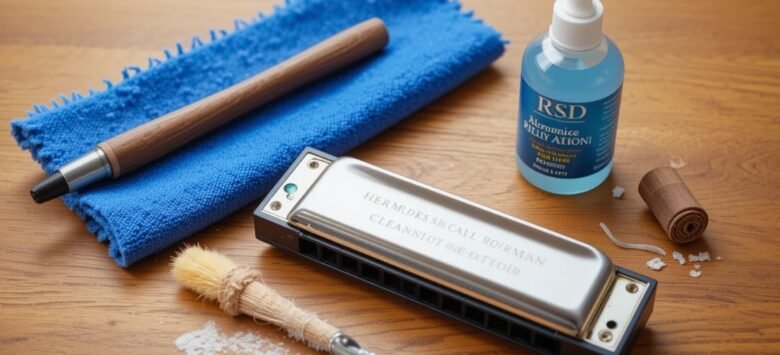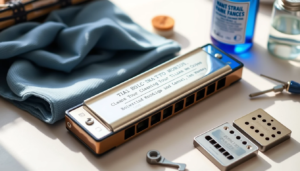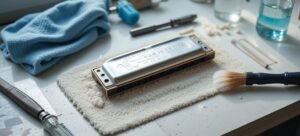Maintaining your harmonica is essential for ensuring its longevity and optimal performance. A well-maintained harmonica not only sounds better but also prevents the buildup of dirt and bacteria. In this guide, you’ll learn step-by-step how to clean and care for your harmonica to keep it in top shape.
Why Cleaning Your Harmonica Matters
Harmonicas are delicate instruments that are often in direct contact with your breath, which can introduce moisture, food particles, and bacteria. Without regular maintenance, these elements can harm the instrument and affect your playing experience. Cleaning your harmonica ensures better hygiene, sound quality, and durability.
Tools You’ll Need
Before diving into the cleaning process, gather these tools:
- A small screwdriver (for disassembling your harmonica)
- A soft-bristle toothbrush or a small cleaning brush
- Warm water
- Mild soap or dishwashing liquid
- A lint-free cloth
- Isopropyl alcohol (for disinfection)
- Cotton swabs
Step 1: Understanding Your Harmonica’s Construction
Most harmonicas have three main parts:
- Cover Plates: The metal plates on the outside.
- Reed Plates: The thin, vibrating metal pieces inside the harmonica.
- Comb: The central part with channels for air to pass through.
Knowing these components will help you clean each part effectively.
Step 2: Basic Daily Maintenance
To keep your harmonica in good condition between deep cleanings, follow these daily habits:
- Tap out excess moisture: After playing, gently tap your harmonica against your palm to remove moisture.
- Avoid eating or drinking sugary beverages before playing: This prevents sticky residue from accumulating inside.
- Wipe the exterior: Use a lint-free cloth to clean the cover plates after each session.
Step 3: Disassembling Your Harmonica
For a deeper clean, you’ll need to disassemble your harmonica. Follow these steps:
- Use the screwdriver to remove the screws holding the cover plates.
- Carefully separate the reed plates and comb.
- Take note of how the parts fit together for easier reassembly.
Note: If your harmonica has wooden combs, avoid soaking them in water to prevent swelling.
Step 4: Cleaning Each Component
- Cover Plates: Wash the cover plates with warm water and mild soap. Use a soft-bristle brush to remove any stuck particles. Rinse thoroughly and dry with a lint-free cloth.
- Reed Plates: Gently brush the reed plates with a toothbrush dipped in warm soapy water. Be cautious not to damage the reeds. Rinse with clean water and let them air dry completely.
- Comb: If your comb is plastic or metal, you can soak it in warm soapy water for a few minutes. Use a brush to clean between the channels. Rinse thoroughly and dry.
Step 5: Disinfecting Your Harmonica
Once all parts are cleaned and dried, disinfect them using isopropyl alcohol. Dip a cotton swab in alcohol and gently wipe down the reed plates and comb. This step ensures that your harmonica is free from harmful bacteria.
Step 6: Reassembling Your Harmonica
Once all components are completely dry, reassemble your harmonica:
- Attach the reed plates back to the comb.
- Secure the cover plates with the screws.
- Test your harmonica to ensure it’s functioning properly.
Additional Tips for Long-Term Care
- Store Properly: Keep your harmonica in a protective case to shield it from dust and damage.
- Avoid Excessive Moisture: Never submerge the entire harmonica in water, as it can damage the reeds and wooden components.
- Use Harmonica-Specific Cleaning Kits: Consider investing in cleaning kits designed specifically for harmonicas to simplify the process.
- Check for Damage: Regularly inspect your harmonica for bent reeds or cracks in the comb and repair them promptly.
Common Mistakes to Avoid
- Overcleaning: Cleaning too frequently or harshly can wear down the reeds.
- Using Harsh Chemicals: Avoid bleach or strong detergents that can damage the harmonica.
- Skipping Drying: Always ensure all components are thoroughly dried before reassembling to prevent rust or mold.
Benefits of Regular Maintenance
Regular cleaning extends the life of your harmonica and ensures a consistent, high-quality sound. It also helps prevent unpleasant odors and reduces the risk of bacterial buildup, making your playing experience healthier and more enjoyable.
Final Thoughts
Taking care of your harmonica doesn’t have to be complicated. With a little effort and regular maintenance, your instrument will remain in excellent condition for years. Clean your harmonica as needed, play with confidence, and enjoy the rich tones of a well-maintained instrument. Happy playing!




Comments
This guide on how to clean and care for your harmonica is so detailed and helpful! I feel much more confident about maintaining my instrument now.
I didn’t realize how important it is to maintain my harmonica properly. This step-by-step guide on harmonica cleaning is a game-changer!